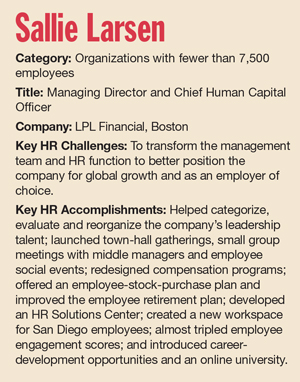This article accompanies The Re-inventor.
Sallie Larsen was on vacation when she got the call.
Mark Casady, the chairman and CEO of LPL Financial, a Boston-based financial-services firm, had just hired Larsen as its new chief human resource officer. But when drafting a press release announcing her new position, Casady elevated her title to chief human capital officer so that all touch points of the employee experience would be under her purview. He called to tell her that she would now serve as managing director and chief human capital officer who would not only oversee HR, but also corporate real estate and corporate communications.
“I took a deep breath,” says Larsen, adding that LPL’s former HR team was seen only as administrative support. “I thought, ‘OK, what does this mean?’ ” Being an optimist, she decided it meant she’d get to “build a wonderful employee experience.”
Since that scenario unfolded three years ago, Larsen has helped transform LPL into a smarter, simpler and more personal company by focusing on three strategic imperatives for the human capital function — attracting, developing and retaining talent; accelerating the company’s leadership agenda; and enhancing the performance culture. By all accounts, she’s had a dramatic impact on employee engagement and overall business performance, a key factor in her being named a 2015 HR Honor Roll recipient.
Under her direction, HR categorized the company’s leadership talent, conducted talent reviews of the organization’s top executives and built communication avenues to the CEO. Early on, she also hosted an executive-leadership workshop that challenged 40 senior leaders to think and work together in new ways.
“She was brought in as my partner and change agent,” says Casady, adding that Larsen helped him hire new heads of technology, operations, risk management and general counsel. “Even in the most difficult situations, cases where I was making a decision to replace someone, Sallie was always there as a discussion partner to help [the individual] understand . . . why change needed to be made. [T]hat won her respect even in situations where we had people [leaving] who were her peers.”
 But the “icing on the cake,” he says, was how she applied the company’s mission — to help investors achieve better outcomes in a conflict-free environment — to the company’s own workforce. Under her guidance, HR began benchmarking and redesigning employee compensation. At least $2 million was invested in new compensation programs. At the same time, she significantly improved LPL’s 401(k) plan, introduced an employee-stock-purchase plan, and launched sustainable corporate-social-responsibility programs that included diversity and inclusion efforts, employee resource groups and volunteerism.
But the “icing on the cake,” he says, was how she applied the company’s mission — to help investors achieve better outcomes in a conflict-free environment — to the company’s own workforce. Under her guidance, HR began benchmarking and redesigning employee compensation. At least $2 million was invested in new compensation programs. At the same time, she significantly improved LPL’s 401(k) plan, introduced an employee-stock-purchase plan, and launched sustainable corporate-social-responsibility programs that included diversity and inclusion efforts, employee resource groups and volunteerism.
Perhaps what Larsen is most surprised at is the HR satisfaction score, which shot up from 35 percent when she first joined the company to 97 percent today. But it shouldn’t surprise her, considering she’s the force behind it. She established town-hall gatherings for the company’s 3,380 employees housed in Boston, San Diego and Charlotte, N.C.; held small group meetings with middle managers; launched annual ice cream socials where employees now take “selfies” with the CEO; increased Casady’s staff interactions through live meetings, blogs, letters and videos; and also started “chirping” (similar to tweeting) personal information about herself and her family on the company’s intranet.
“[Employees] are my extended family,” Larsen says, adding that, in one chirp, she compared her personal habit of clipping coupons to financial stewardship. “They say, ‘It makes me feel I know you because you have the same issues, events and struggles in your life that I have in mine.’ ”
Larsen also created an online HR portal for direct employee access and an HR Solutions Center to address employee questions. Likewise, a new onboarding process was implemented to enhance assimilation and shorten the learning curve. Pathways was also introduced, a new program that offers career counseling, self-evaluations and other career-development tools.
Since employees had difficulty connecting professional development to career and business growth, Larsen and her team built an online university with colleges offering educational opportunities that aligned to the needs of specific business functions.
Last year, Larsen was also heavily involved in building a new San Diego office that is LEED (Leadership in Energy and Environmental Design)-platinum certified. The building contains an on-site fitness center and a health clinic where employees can get free medical care. Workers can even adjust their own lighting and thermal controls in their workspace.
Still, tackling this much change did present many challenges, such as prioritizing tasks and evolving the company. After one implementation, she says, her team realized it “should just take some time and reflect. Is everything we put in great? If not, what’s wrong with it? What should we have done differently? It’s fine to have all these great foundational programs in place, but at some point, you have to pause and work on adoption . . . do the post-mortem.”
Larsen readily admits that she embraces change and thrives in environments that demand it. “I’m an entrepreneur,” she says, “with a very practical side.”

